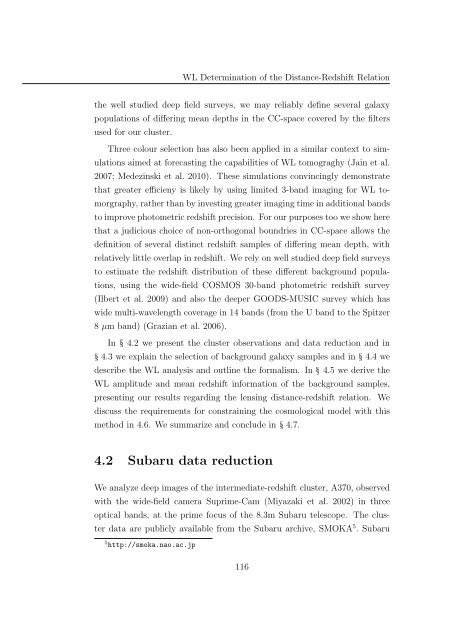Mass and Light distributions in Clusters of Galaxies - Henry A ...
Mass and Light distributions in Clusters of Galaxies - Henry A ...
Mass and Light distributions in Clusters of Galaxies - Henry A ...
Create successful ePaper yourself
Turn your PDF publications into a flip-book with our unique Google optimized e-Paper software.
WL Determ<strong>in</strong>ation <strong>of</strong> the Distance-Redshift Relation<br />
the well studied deep field surveys, we may reliably def<strong>in</strong>e several galaxy<br />
populations <strong>of</strong> differ<strong>in</strong>g mean depths <strong>in</strong> the CC-space covered by the filters<br />
used for our cluster.<br />
Three colour selection has also been applied <strong>in</strong> a similar context to simulations<br />
aimed at forecast<strong>in</strong>g the capabilities <strong>of</strong> WL tomograghy (Ja<strong>in</strong> et al.<br />
2007; Medez<strong>in</strong>ski et al. 2010). These simulations conv<strong>in</strong>c<strong>in</strong>gly demonstrate<br />
that greater efficieny is likely by us<strong>in</strong>g limited 3-b<strong>and</strong> imag<strong>in</strong>g for WL tomorgraphy,<br />
rather than by <strong>in</strong>vest<strong>in</strong>g greater imag<strong>in</strong>g time <strong>in</strong> additional b<strong>and</strong>s<br />
to improve photometric redshift precision. For our purposes too we show here<br />
that a judicious choice <strong>of</strong> non-orthogonal boundries <strong>in</strong> CC-space allows the<br />
def<strong>in</strong>ition <strong>of</strong> several dist<strong>in</strong>ct redshift samples <strong>of</strong> differ<strong>in</strong>g mean depth, with<br />
relatively little overlap <strong>in</strong> redshift. We rely on well studied deep field surveys<br />
to estimate the redshift distribution <strong>of</strong> these different background populations,<br />
us<strong>in</strong>g the wide-field COSMOS 30-b<strong>and</strong> photometric redshift survey<br />
(Ilbert et al. 2009) <strong>and</strong> also the deeper GOODS-MUSIC survey which has<br />
wide multi-wavelength coverage <strong>in</strong> 14 b<strong>and</strong>s (from the U b<strong>and</strong> to the Spitzer<br />
8 µm b<strong>and</strong>) (Grazian et al. 2006).<br />
In § 4.2 we present the cluster observations <strong>and</strong> data reduction <strong>and</strong> <strong>in</strong><br />
§ 4.3 we expla<strong>in</strong> the selection <strong>of</strong> background galaxy samples <strong>and</strong> <strong>in</strong> § 4.4 we<br />
describe the WL analysis <strong>and</strong> outl<strong>in</strong>e the formalism. In § 4.5 we derive the<br />
WL amplitude <strong>and</strong> mean redshift <strong>in</strong>formation <strong>of</strong> the background samples,<br />
present<strong>in</strong>g our results regard<strong>in</strong>g the lens<strong>in</strong>g distance-redshift relation. We<br />
discuss the requirements for constra<strong>in</strong><strong>in</strong>g the cosmological model with this<br />
method <strong>in</strong> 4.6. We summarize <strong>and</strong> conclude <strong>in</strong> § 4.7.<br />
4.2 Subaru data reduction<br />
We analyze deep images <strong>of</strong> the <strong>in</strong>termediate-redshift cluster, A370, observed<br />
with the wide-field camera Suprime-Cam (Miyazaki et al. 2002) <strong>in</strong> three<br />
optical b<strong>and</strong>s, at the prime focus <strong>of</strong> the 8.3m Subaru telescope. The cluster<br />
data are publicly available from the Subaru archive, SMOKA 5 . Subaru<br />
5 http://smoka.nao.ac.jp<br />
116
















